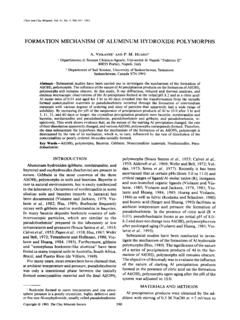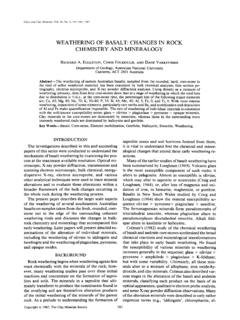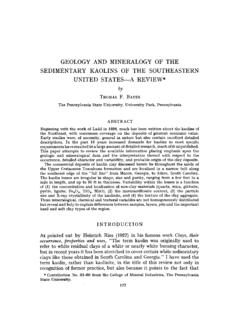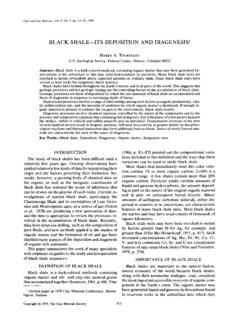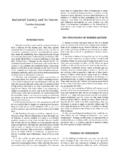Transcription of by - The Clay Minerals Society
1 INDUSTI~IAL APPLICATIONS OF KAOLIN by HAYDN H. MURRAY Georgia Kaolin Company, Elizabeth, New Jersey ABSTRACT Kaolins are used in a multiplicity of industries because of unique physical and chemical properties. Shape, particle size, color, softness, and non-abrasiveness are physical properties that are especially important. Chemical properties, such as comparatively low base exchange capacity, as well as ether chemical properties of the kaolin surface, and relative insolubility, are governing in many uses. In 1960, well over 2,000,000 tons of kaolin was used in the United States, more than one-half of which was consumed by the paper industry.
2 The relationships between physical and chemical properties are discussed in the application of kaolin to paper, rubber, ceramics, plastics, ink, catalysis, insecticides, and numerous other uses. A few new uses of kaolin are discussed along with a shorg gaze into a crystal ball to see what the future may hold for that useful mineral, kaolin. INTRODUCTION The industrial mineral kaolin has many uses. It has favorable properties such as natural whiteness, fine particle size, non-abrasiveness, and chemical stability.
3 Kaolinite is the proper name of the mineral about which this article is written, but in industrial terminology the mineral is known as kaolin, so all references will be to kaolin. The largest known deposits of kaolin in the United States are in Georgia and South Carolina. These deposits are Sedimen- tary and occur as lenticular bodies in the Tusealoosa Formation of Cretaceous Age (Murray, 1960, p. 280). Natural processes in the geologic past have segregated the kaolins and deposited them in relatively pure lenses.
4 The kaolins vary in their degree of crystal perfection which affects many proper- ties (Murray and Lyons, 1956; Murray and Lyons, 1960). For this and other reasons, the crude kaolin is tested extensively before the deposit is prepared for mining. The theoretical chemical composition of kaolin and a chemical analysis of a crude kaolin from Dry Branch, Georgia, shown below, indicate the relative purity of many of the Cretaecous kaolins in Georgia and South Carolina. Two basically different processes are used to refine kaolins and remove the major impurities.
5 The simplest process is called Mr flotation or the dry process. The properties of the finished product depend to a large extent on those properties inherent in the crude kaolin. In the dry process operation, a deposit must be chosen with desirable properties of color and relatively low 291 292 TENTH IklATIONAL CONFERENCE ON CLAYS AI~D CLAY Minerals Aluminum oxide Silicon dioxide Iron oxide Titanium dioxide Calcim~n oxide Magnesium oxide Sodium oxide Potassium oxide Ignition loss Theoretical kaolinite Kaolin from Georgia -- -- -- -- -- -- ] content of grit ( > 44/x).
6 The crude kaolin is transported to the mill where the large chunks are reduced to about egg size by roll crushers. The crushed kaolin is fed into rotary driers and then into airfloating equipment. The latter usually consists of a pulverizing unit and an air separator. The fine particles are transported to collecting chambers and the coarse particles are fed back into the pulverizer. Dry processing yields a product of relatively low cost. The second process used to produce kaolins is much more complex and is called the wet process.
7 The kaolin is dispersed in water after it is mined. The first step after dispersion is the removal of the coarse grit ( > 44/x) by settling procedures and vibrating screens. The resultant degritted slurry is fed into centrifuges to separate the kaolin into fine, intermediate, and coarse particle size fractions. These fractions can be chemically bleached to remove some coloration caused by iron impurities. The kaolin is then dewatered through a filtration process, dried in either rotary, apron or spray driers, and prepared for shipment.
8 This process is used to produce highly refined kaolins having controlled properties. Kaolin has many industrial uses. In addition to the general properties mentioned in the first paragraph, it is soft, has low viscosity at high solids content in many systems, is readily wet and dispersed in water and some organic systems, and can be produced with a controlled particle size distribu- tion. Some of the important physical constants of kaolin are: specific gravity, ; index of refraction, ; hardness (Mobs scale), 2; fusion temperature, 1850 ~ C; dry brightness, 78-92 percent, i As mentioned previously many kaolins have a low viscosity at relatively high solids content.
9 For example, many kaolins can be dispersed readily in water at 70 percent solids by weight and the resultant slurry pours like fresh milk. This is an attractive property for the paper coating industry as will be pointed out later. The ranges of particle size distribution in which kaolins are produced commercially are shown in Fig. 1. Several end uses of kaolin depend upon the i Measured at 458 m# on a General Electric recording speetrophotometer, against MgO reference, industrial APPLICATIONS OF KAOLIN 293 particle size distribution.
10 In many applications a coarse-particle kaolin may not work whereas a fine-particle kaolin will, and vice versa. Some of the more important industrial uses will be described in this paper, but it must be ~oo I 90 8O 70 5O FIOUtlE ,~o' 3~ i 20 I0 0 5O 20 I0 5 2 ~ 05 0,2 MICRONS size distribution curves of commercially available kaolins. realized that these descriptions, of necessity, are brief and incomplete. More than 2,000,000 tons of kaolin is used annually in the United States (de Polo, 1960, ). The author wishes to acknowledge the help of Dr.

